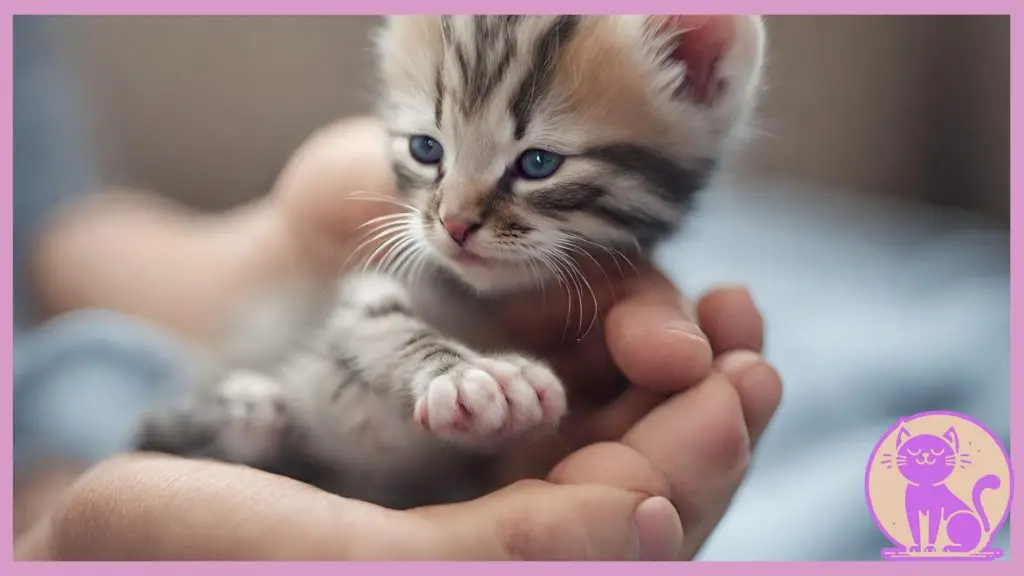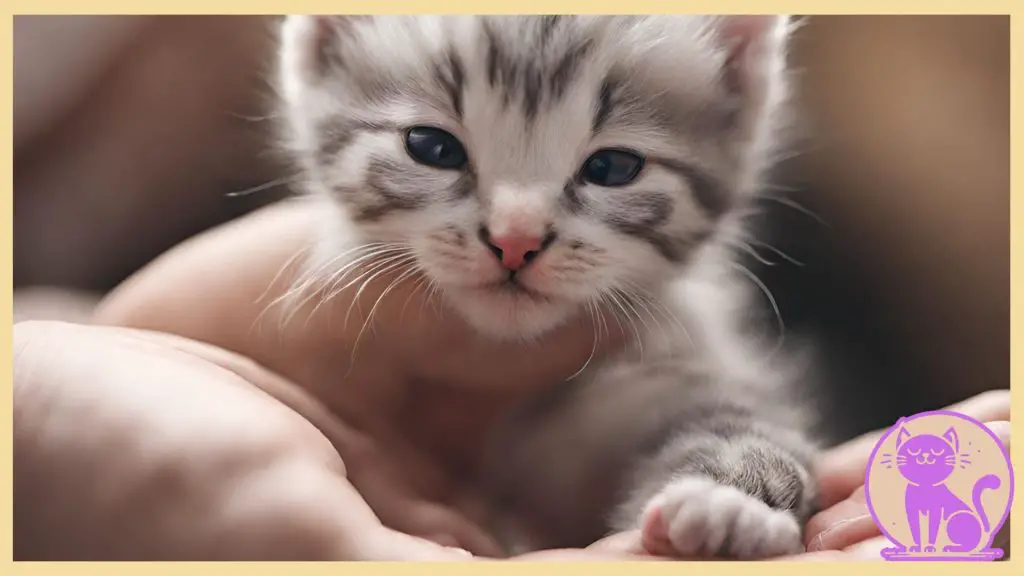Embarking on the journey of nurturing newborn kittens can stir a mixture of emotions, from overwhelming joy to a sense of protective caution. These tiny beings, with their delicate purrs and soft fur, naturally invite our touch. Yet, many caretakers wrestle with the question: Is it safe to touch baby cats? Understanding the intricacies of kitten care tips starts with respect for their early life needs and recognizing their susceptibility to external factors. This opening discussion sheds light on the vital aspects of early kitten care while addressing the common concerns surrounding the well-being of these adorable creatures when they’re most vulnerable.
Understanding the Sensitivity of Newborn Kittens

The earliest days in a kitten’s life are pivotal not only for physical growth but also for developing a healthy immune response. Newborn kittens are born with an undeveloped immune system which relies heavily on the antibodies received from their mother’s milk, particularly the colostrum produced in the first few days post-delivery. In this critical phase, caring for kittens with delicacy is paramount to safeguard their vulnerable health.
The First Weeks of Life
In their initial weeks, kittens experience rapid physiological changes, a time when close monitoring of their development is essential. These bundles of fur depend on their mother not just for nutrition but also for warmth and protection, indicating the interwoven nature of newborn kittens’ health and maternal care. Adjusting to the world outside the womb, they undergo significant development that is as delicate as it is crucial.
Protecting the Vulnerable: Immune Systems of Baby Cats
Protecting the fragile immune systems of infant felines necessitates an environment free of excessive handling and potential pathogens. It cannot be overstressed that in these tender weeks, caring for kittens adequately means minimizing their exposure to possible health risks and ensuring that the conditions under which they are nurtured support their still developing immune defenses.
| Age (Weeks) | Milestones in Immune Development | Recommended Care Considerations |
|---|---|---|
| 0-2 | Antibodies absorbed from colostrum | Limit handling, ensure kittens stay with the mother |
| 2-4 | Initial vaccination can be considered | Continue limited handling, maintain a clean environment |
| 4-8 | Antibody levels from mother begin to wane | Begin socialization; keep a watchful eye on health signs |
| 8-12 | Improvement in self-produced antibodies | Safely increase interactive play, complete vaccination schedule |
By understanding and responding to the needs of kittens as they embark on life’s journey, we become stewards of their burgeoning wellness and ensure a foundation for lively and spirited cat adulthood.
When Is It Safe to Start Handling Newborn Kittens?

Appropriately timing your interactions with newborn kittens is crucial for their health and development. Handling newborn kittens is not only a matter of proper technique but also of timing, as their immunity and comfort with humans gradually develop.
The Timeline for Handling: Typically, handling newborn kittens can commence once they reach the age of about 2 to 3 weeks. Prior to this, minimal handling is recommended, principally to allow them to bond with their mother and to enable their immune systems to mature. During this early period, ensure any necessary touching is gentle and brief.
Health Status Checks: It is imperative to continually monitor the well-being of the kittens. Healthy kittens will exhibit steady growth, clear eyes, and good appetites. Any signs of distress or illness should be a signal to limit handling and seek veterinary advice.
Mother Cat’s Presence: The mother cat’s behavior should guide interactions. If she is calm and trusts the human caregiver, handling may be introduced earlier and more frequently. Respect her instincts— if she appears anxious or protective, it’s wise to give her and the kittens more space.
Kitten Care Tips: When beginning to handle kittens, keep sessions short, around 5 to 10 minutes. Wash your hands before and after to prevent the spread of germs, and handle kittens in a quiet, enclosed space to avoid overstimulation.
With these guidelines in mind, you can ensure that the handling of newborn kittens contributes positively to their growth and socialization, laying the foundation for well-adjusted young cats.
How Mother Cats Care for Their Young
Understanding the intricate behaviors of mother cats nurturing their kittens provides invaluable insight into the world of feline care. The natural instincts of a mother cat to provide for her offspring encompasses a range of activities that ensure the growth and development of her kittens.
The Bond Between Mother Cat and Kittens
The connection between a mother cat and her kittens is profound. From birth, kittens are completely reliant on their mother for nourishment, warmth, and protection. This bond is critical for the survival of the kittens and plays a significant role in their physical and behavioral development. Mother cats display a remarkable level of nurturing, regularly cleaning and grooming their kittens to maintain their hygiene and comfort. The act of nursing further solidifies their bond, releasing endorphins that promote a sense of contentment and security among the litter.
How Feline Mothers Communicate with Their Offspring
Communication between mother cats and their kittens takes on many forms, ensuring that critical lessons in kitten behavior are passed down. Vocal communication is key; soft murmurs and purrs often serve as signals of comfort or as calls for the kittens to follow. Body language and touch also play pivotal roles in feline communication. Understanding these subtle cues is essential for providing the best care for kittens, especially when assessing the need for human intervention. A mother cat’s cues can often be indicators of whether the kittens are content, feeling distressed, or require more care.
| Behavior | Description | Purpose |
|---|---|---|
| Grooming | Mother licks the kittens’ fur | Cleanliness and stimulation of bodily functions |
| Nursing | Kittens feed from the mother | Nutrition and bonding |
| Teaching | Mother leads kittens to explore | Developing independence and survival skills |
| Discipline | Soft nips or pats with a paw | Establishing boundaries and behavioral correction |
| Comforting | Purring and close physical contact | Providing a sense of security and reducing stress |
As kittens grow, the nurturing provided by their mother plays an integral role in shaping their future interactions and overall demeanor. Observing and honoring the natural processes of mother cats in caring for kittens not only ensures the well-being of the young cats but also enriches the understanding and appreciation for the complex dynamics of feline behavior.
Best Practices for Interacting with Newborn Kittens

Interacting with newborn kittens requires a gentle and informed approach. These baby cats are not only adorable but also extremely vulnerable during the first weeks of life. To ensure their safety and well-being, it’s crucial to follow specific kitten care tips that cater to their delicate nature.
The Importance of Timing: It’s essential to consider the timing of your interactions carefully. Baby cats should spend most of their early life with their mother, who provides them with warmth, food, and critical socialization skills. In general, handling should be kept to a minimum, especially within the first two weeks of life.
- Wait until kittens are at least two weeks old before you begin to handle them gently.
- Touch them when they are awake and in a peaceful state, not during their sleep to avoid disruption to their rest.
- Ensure that all interactions are supervised by an adult, familiar with kitten care tips, to prevent accidental harm.
Sanitization is Key: To protect the kittens from potential infections, make sure you sanitize your hands before and after touching them. Their immune systems are not fully developed, and they’re more susceptible to diseases. This is also important if you’re interacting with multiple kittens to prevent the spread of any illness.
Soft Touch: When handling kittens, use a soft touch and support their bodies fully. Cradle them gently against your body to offer warmth and security. Avoid rough play or any movement that might startle or stress the tiny creatures.
Monitor Their Reactions: Observing kittens’ reactions when you interact with them will give you valuable insight into whether they’re comfortable or not. If a kitten seems anxious or tries to wriggle away, give them some space and try again later.
- Look for signs of contentment, such as purring or kneading.
- Notice any signs of stress, including hissing, arching their back, or flattening their ears.
- If a kitten consistently shows signs of distress, consult a veterinarian or a kitten care specialist.
Learning how to interact appropriately with newborn kittens is not just about immediate care. It’s also about setting the stage for their future health and socialization. By adhering to these kitten care tips, you’ll help ensure that these baby cats grow up to be happy, healthy, and well-adjusted adult cats.
Risks to Consider Before Touching Baby Cats

When it comes to kittens health, understanding the delicate balance between nurturing and protecting becomes paramount. A kitten’s wellbeing could be compromised by well-intentioned, but misinformed handling. Recognizing the dual responsibility to safeguard these vulnerable lifeforms against illness and undue stress is essential for any caretaker.
Preventing the Transmission of Illness
Cats, especially newborns, are sensitive to their environment and can easily contract diseases from humans. Preventative measures are crucial to maintaining a hygienic space and minimizing the risk of infection. Handwashing and the use of sanitizers can drastically reduce the spread of pathogens, thereby preventing kitten illness. Understanding that some human diseases can be zoonotic is a step towards ensuring the kittens’ robust health.
Understanding Stress Signals in Newborn Kittens
Newborn kittens communicate discomfort through various stress signals, which can be a direct outcome of excessive or improper handling. Being able to interpret their behavior serves as an indicator of their comfort level. Subtle signs such as excessive vocalizations, avoidance behavior, and changes in body language are often cries for space and should be respected to maintain their emotional well-being.
| Stress Signal | Description | Recommended Actions |
|---|---|---|
| Shrinking away | Kittens pull back or try to escape the touch | Give them space; limit handling |
| Hissing or spitting | Aggressive protective behaviors | Ensure a quiet environment; avoid sudden movements |
| Flattened ears | Indicates fear or discomfort | Reduce noise levels and interactions |
| Excessive Meowing | Could signal distress or discomfort | Check for physical needs (hunger, cold) |
Recognizing these stress indicators and responding appropriately ensures that kittens grow in a stress-free environment, contributing to their developmental success and overall health. It’s a step towards crafting a nurturing atmosphere that aligns with the intricate nature of kitten care.
Fostering a Safe Environment for Kitten Development
As you embark on the rewarding journey of raising young cats, creating a safe kitten environment is critical for their overall health and well-being. Such an environment not only fosters kittens development but also instills a sense of security in these young felines, allowing them to thrive physically and emotionally. Below, discover the actionable measures you can implement to ensure that the space you provide nurtures their growth.
Creating a Calming Space for Kittens
Young kittens require an area where they feel protected and at ease to explore their new world. Minimizing loud noises and establishing a serene atmosphere are key components of a nurturing environment. Use soft bedding and keep the space at a comfortable temperature away from drafts. You can also include a ticking clock or soft music to provide a soothing background sound, subtly enhancing the calming ambiance.
The Essentials: Warmth, Quiet, and Comfort
Beyond tranquility, the core elements vital for a kitten’s sanctuary are warmth, quiet, and comfort. Achieving these is simple yet profound:
- Warmth: A heat lamp or warming pad can offer a steady heat source, akin to the presence of a mother cat.
- Quiet: Choose a low-traffic area in your home to keep disturbances to a minimum, safeguarding the kittens’ delicate sleep cycles.
- Comfort: Soft, washable bedding will make clean-ups easier and maintain a hygienic space necessary for their development.
By meticulously constructing a habitat that emphasizes these essentials, you’ll be well on your way to providing an optimal setting for the growth and happiness of your young feline friends.
Feeding Newborn Kittens: Human Interactions and Their Effects

When taking on the role of a surrogate cat parent, mastering the technique of feeding newborn kittens is paramount for their survival. Just like human infants, newborn kittens require frequent, nutrient-rich feedings, but how and what you feed these fragile creatures will have longstanding effects on their health and behavior. Adhering to proper kitten care tips and understanding the needs of these young felines will ensure a smooth hand-rearing process.
Feeding must mimic the natural intervals, usually every two to three hours for the first few weeks of life, including overnight. This is where human interactions play a critical role. The warmth of your hands, the gentleness of your touch, and the sound of your voice contribute significantly to creating a bond and a sense of security for the kittens. It is not just about sustenance but caring for kittens in a holistic sense, providing comfort and a pseudo-feline experience.
One of the primary concerns is ensuring that the formula provided is of high quality and specifically designed for kittens. Cow’s milk or other milk substitutes designed for humans are inappropriate and can lead to health issues such as diarrhea. A well-formulated kitten milk replacement should be warmed to just above room temperature for feedings, simulating a more natural eating experience.
- Bottle feeding: Newborn kittens typically take to a small nursing bottle with a nipple designed to imitate the mother cat’s teat.
- Tube feeding: In certain cases, particularly with weaker or ill kittens, tube feeding may be necessary. This is a delicate procedure and should only be carried out under the guidance of a veterinarian.
- Weaning: As kittens grow, they’ll begin transitioning to solid food. Weaning should be a gradual process, mixing formula with high-quality kitten food to create a soft slurry.
During feeding, monitor the kittens’ body language and response to feeding interactions closely. With your care, they should steadily gain weight, appear content, and sleep soundly between feedings. If a kitten is struggling, shows disinterest in feeding, or is lethargic, it may be a cue for a prompt visit to the vet.
Always remember, the ultimate goal of feeding newborn kittens is not just to fulfill their nutritional requirements but also to foster a nurturing relationship that promotes their physical health and psychological well-being. Kitten care tips often highlight the feeding process as a critical stage for kitten development, where human bonds are formed and behavioral foundations are laid.
Whether you are an experienced foster or a first-time kitten caregiver, understanding the significance of your interactions during feeding will greatly assist the health and happiness of your feline charges. Caring for and feeding newborn kittens can be a deeply rewarding experience, laying the foundation for their successful growth into healthy, socialized adult cats.
Behavioral Signs to Watch for In Newborn Kittens
Even the tiniest feline behaviors can speak volumes about newborn kittens’ health and wellbeing. For the caring observer, distinguishing between what’s normal and what may be a call for help is crucial in kitten care. This segment examines common kitten behavior and provides kitten care tips to help you identify when to step in or let mother nature take its course.
Normal Vs. Worrying Kitten Behaviors During Early Weeks
During the early weeks of life, normal kitten behavior typically includes nursing every 1-2 hours, steady weight gain, and a significant amount of sleep. Kittens should start to crawl around the 2-week mark and begin playful interactions with littermates as they approach 4 weeks of age. These behaviors are good indicators of a kitten’s progressing development and overall newborn kittens’ health.
In contrast, worrying behaviors might include prolonged crying, which can signal hunger or distress, lethargy outside of normal sleeping times, or a refusal to nurse. Furthermore, if a kitten is isolated from its littermates or rejected by the mother, it may require human intervention. Witnessing these signs early is key to addressing potential health issues promptly.
Interpreting Kitten Behavior: When to Interact and When to Step Back
Understanding the subtle, yet expressive cues in kitten behavior can inform your decision-making. If you spot a kitten that’s snuggled with its siblings and engaging in contented purring, there’s likely no need for concern or human interruption. However, it’s crucial to interact, with gentleness, when kittens exhibit isolation, failure to thrive, or evident discomfort.
As kittens open their eyes and begin exploring, encourage them with gentle play, which aids in their social development and agility. Always monitor these interactions closely, ready to provide a safe retreat for these vulnerable beings. By tapping into the wealth of knowledge on kitten care tips, you’ll be better equipped to nurture their growth and contribute to a thriving start to kittenhood.
Conclusion
Throughout this exploration of nurturing newborn kittens, we have traversed the intricate path of their early lives, emphasizing the vital role responsible care plays in their development. From the initial stages, where the immune systems of these delicate baby cats are just beginning to form, to the critical aspects of their feeding and environmental needs, we have provided a comprehensive guide brimming with kitten care tips. It has been our goal to equip you with the knowledge necessary to ensure that your interactions with these vulnerable creatures are both safe and supportive.
Indeed, the journey of caring for kittens is filled with both joy and caution. It requires patience, as even the simple act of touching can wield large impacts on their well-being. This article has highlighted the importance of timing, the mother cat’s role, and the understanding of stress signals and behavioral cues. These foundations aid us in fostering an environment where newborn kittens can flourish – one that is replete with warmth, tranquility, and comfort.
As we conclude, remember that the formation of a kitten’s life is delicately in your hands. Gentle interactions and a deep comprehension of the nuances of kitten behavior are indispensable to their nurturing process. By adhering to the guidelines and wisdom imparted here, you can contribute to the blossoming of healthy, happy felines well into their nine lives.
FAQ
Q: Can you touch newborn kittens?
A: It is generally advisable to avoid unnecessary handling of newborn kittens for the first few weeks of life unless it’s for essential care or on the advice of a veterinarian. This helps protect their developing immune system and minimizes stress.
Q: Why are newborn kittens so sensitive?
A: Newborn kittens are very delicate as their immune systems are not yet fully developed. They rely on antibodies from their mother’s milk to help protect them from illnesses. Additionally, they are physically fragile and need gentle care.
Q: When is it safe to start handling newborn kittens?
A: It’s considered safe to start handling kittens more frequently once they are around 2-3 weeks old. By this time, they have had some time to grow, their eyes are open, and they are starting to interact with their environment.
Q: How do mother cats care for their young?
A: Mother cats care for their kittens by keeping them warm, grooming them, and providing milk. They also teach their kittens important behaviors and help them with the weaning process when they are ready to start eating solid food.
Q: What are the best practices for interacting with newborn kittens?
A: Best practices include washing your hands before and after touching kittens, being very gentle, and making sure they are warm and comfortable. Any socialization or handling should be done gradually and under the guidance of a caregiver or veterinarian.
Q: What risks should be considered before handling newborn kittens?
A: Handling kittens can pose risks such as the transmission of disease or causing them stress. It’s important to be fully aware of these risks and to monitor kittens closely for any signs of distress or illness.
Q: How can you foster a safe environment for kitten development?
A: To foster a safe environment, ensure that the kittens have a clean, warm, quiet, and comfortable space. Limit their exposure to loud noises, other pets, and unfamiliar people during the first few weeks of life.
Q: What should you know about feeding newborn kittens?
A: If you are responsible for feeding newborn kittens, you will need to use a kitten milk replacement formula and feed them at regular intervals, generally every 2-3 hours. Avoid cow’s milk as it can lead to health issues.
Q: What behavioral signs should you watch for in newborn kittens?
A: Normal behaviors include suckling, kneading, and snuggling with their littermates and mother. Watch for concerning signs like prolonged crying, lethargy, or not gaining weight, which could indicate a need for veterinary intervention.








